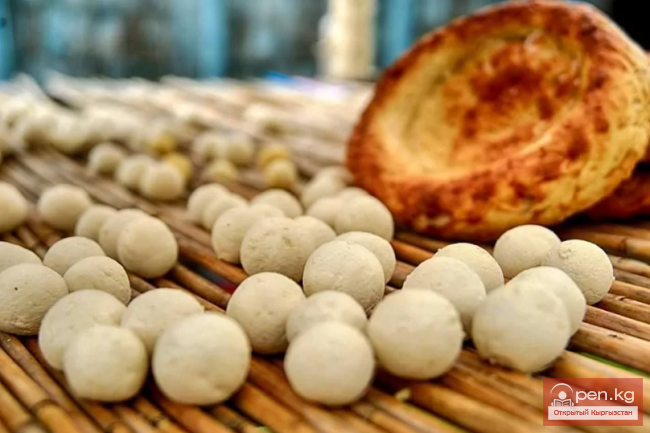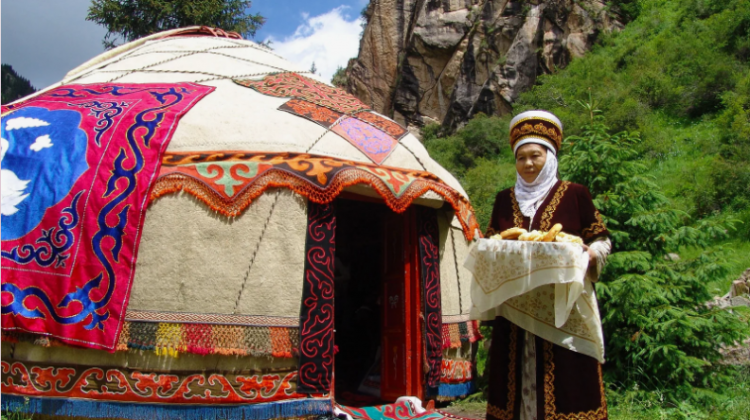
Kumis – a fermented milk drink. It is made from mare's milk, and less frequently from cow or...

Chalap — a general name for a fermented milk drink. The art of making this fermented milk drink...

Drink "Tan" The manufacturer of the drink "TAN", LLC "Artezian",...

Milk and Dairy Products. In the traditional diet of the Kyrgyz, among all products available to...

Kyrgyz people are known for their kumis — a healing drink made from mare's milk, notes the...

In one of the most ecologically clean areas of Kyrgyzstan - the Suusamyr Valley, the Kumys...

Location: Kyrgyz Republic, Naryn Region, Kochkor District, Ak-Kiya village...

BLESSING (BATA BERUU) BLESSING (BATA BERUU)...

Sakas The ancient herders who inhabited Central Asia left no historical writings. The ancient...

Where there is a guest, there is joy and abundance. "It is a sin to leave a hospitable home...

Saka and Scythians through the Eyes of Cherilus The author of the poem "Persica," the...

Kyrgyz cuisine is rich and unique. The Kyrgyz are a nomadic people, representatives of an ancient...

Ayran Ayran is a fermented dairy product common in Central Asia. It is a thick mixture that tastes...

The first reliable traces of humans on the territory of Kyrgyzstan date back to the Paleolithic —...

Farmer Guest Complex "Chon-Terek" - Kumys Treatment Center. The guest complex is located...

In the material culture of any ethnic group, there is a distinctive cuisine. It is no coincidence...

Gyan-gun and Dinlins In the sources of the 1st-2nd centuries AD, the gyan-gun are not mentioned,...

This special soup is prepared and served in conjunction with the ritual "Bertik Suruu."...

The cultures of the ancient peoples of Kyrgyzstan are considered in close connection with one...

Divers managed to retrieve many finds from the bottom, including a whole ceramic vessel, a large...

Hotel "Marco Polo" - the only modern and comfortable hotel on the southern shore. The...

Permits for hunting in Kyrgyzstan are arranged in advance by the hunting organizers. For this,...

Maksym or Zharmа Kyrgyz national refreshing drink, known by other names (achyma, achygan kozho,...
Kyrgyz - ancient nomads...

Ulus Inga-Tyuri During military clashes, it appears that part of the "Central Asian"...
The expenses of the World Nomad Games are laughable compared to the Olympics, but the image,...

Jalal-Abad Deposit is located on the left bank of the Kugar River valley on the southeastern...

The History of Moghulistan from Eastern Written Sources We move on to the characteristics of...

The Influence of Mongol Rule All the devastating hordes of Genghis Khan's army played their...

Kyrgyz Dishes. In folk tales and songs, as well as in epics, there are often mentions of this. The...

The word is the soul of the people! Each proverb is a true gem, extracted from the depths of the...

The Food Culture of the Kyrgyz The formation of the traditional food culture of the Kyrgyz went...

Water - The Basis of Life The peoples of Central Asia and Kazakhstan, who roamed the endless...

The situation surrounding the Ukrainian conflict has reached a deadlock following a phone call...

Balasagun One of the capitals of the Karakhanid state was the city of Balasagun, located in the...

The city of Osh — a multinational city The archaeological research of the city of Osh was...

Ancient People — Kyrgyz The Kyrgyz, whose roots go deep into antiquity, lost in the darkness of...

The traces of primitive human activity in the territory of the Kyrgyz Republic date back to the...

Bal (sweet drink) Popular among the Kyrgyz, bal is a sweet hot drink made from honey with the...

Kyrgyz-Gyangu The earliest mention of the Kyrgyz under the Chinese name “gyan-gun”, “heguni”, or...

Balgam. This is an ancient meat dish of nomads, which was also specially prepared in very rare...

Resettlement of the Kyrgyz to the Yenisei. The early medieval population of the Yenisei was...
Since ancient times, Kyrgyz people have placed great importance on the presentation of meat. If...

Healthcare in the Kyrgyz Republic Before the revolution, the residents of Central Asia were...

Kyrgyz in Kazakhstan. Small groups of ethnic Kyrgyz have found themselves in various parts of...

In the history of Kyrgyzstan, an interesting figure was and remains Shabdan Batyr....

Khudyakov Yuliy Sergeyevich (1947), Doctor of Historical Sciences (1988), Professor (1991)...